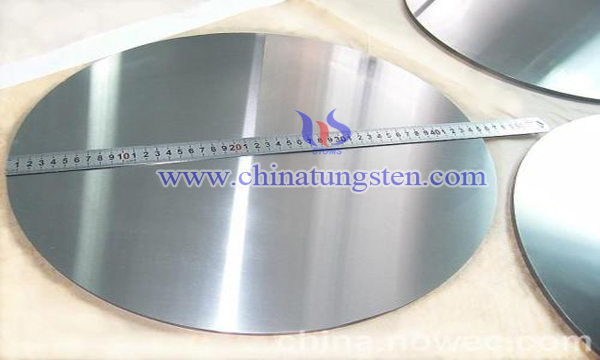Vacuum Extension Method for Tungsten Target Preparation
- Details
- Category: Tungsten Information
- Published on Tuesday, 12 February 2019 21:49
Large-scale integrated circuits often use tungsten target for vacuum sputtering, especially large-size tungsten target. In the current semiconductor field, large-size tungsten target has a diameter of 300 mm-450 mm and a thickness of 6 mm-15 mm. However, with the development of semiconductor industry, tungsten target of this size can not meet the industrial needs.

As tungsten is a refractory metal, it is difficult to produce larger tungsten target by traditional powder metallurgy method. In order to overcome the shortcomings of the existing technology, some enterprises have adopted a vacuum calendering method to prepare tungsten target, which needs to be roughly described.
1.Using tungsten or tungsten alloys with purity of 99.9% or more to manufacture circular targets with diameter of 200 mm and thickness of 56 mm, the actual processing dimension of the blank thickness of tungsten targets will add 3 mm to 10 mm processing allowance to the design dimension.
Secondly, the surface of tungsten target blank is machined to make the surface of tungsten target blank smooth and bright, and to achieve the necessary smoothness, so as to prevent wrinkles in subsequent calendering process of tungsten target blank.
2.Place the machined tungsten target blank into the vacuum envelope and vacuum it. The material selection of vacuum cladding should meet the requirement that the melting point is higher than the temperature during heating. Low carbon steel can be used, combined with the coating thickness of 1.0 mm to 3.0 mm, so as to achieve good pressure conduction effect, and there will be no easy cracking at welding and calendering sites, resulting in gas leakage.
3.Seal the envelope and leave the gas pipe. Then start vacuum pumping, to a certain extent, for example, when the vacuum degree reaches at least 10-3 pa, put the package into the heating furnace for the first heat treatment, after the temperature is 200-500 ℃, then carry out the thermal insulation step, holding for 2-5 H.
4.Forging the tungsten target blank in the vacuum envelope. The sealed envelope is placed in the reheating furnace for the second heat treatment. The temperature of the second heat treatment is 900-1500 ℃. At this temperature, the envelope is kept for 1h-5h and then forged. In order to eliminate the casting defects such as looseness of original casting structure in tungsten target blank, optimize the micro-structure of tungsten target blank, break the columnar grains of tungsten target blank into fine grains, repair the pore inside the tungsten target blank, and then make its internal structure from looseness to compactness.
6. Calendering of tungsten target blank in forged vacuum envelope. Calendering is a multi-pass calendering process. In order to make the heat in the vacuum jacket diffuse better, the tungsten target blank is uniformly heated. In practical application, the calendering amount per calendering can be adjusted accordingly according to the actual demand, so that the tungsten target blank can be calendered to meet the size of tungsten target for semiconductor target in the best way.
The tungsten target blank is sealed by vacuum envelope, then forged and calendered, and finally cooled and removed to form the tungsten target. In this process, cracks and surface oxidation are avoided when the tungsten target blank is processed and extended in air. The tungsten target with uniform internal structure and uniform grain size meets the requirements of sputtering target can be fabricated. Moreover, it has the advantages of easy processing and low waste rate, and can easily meet the needs of large-scale tungsten target production.
- Tungsten Manufacturer & Supplier, Chinatungsten Online: www.chinatungsten.com
- Tungsten News & Prices of China Tungsten Industry Association: www.ctia.com.cn
- Molybdenum News & Price: news.molybdenum.com.cn
- Tel.: 86 592 5129696; Fax: 86 592 5129797; Email: sales@chinatungsten.com



 sales@chinatungsten.com
sales@chinatungsten.com